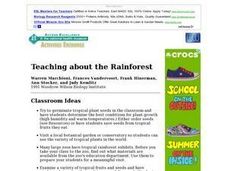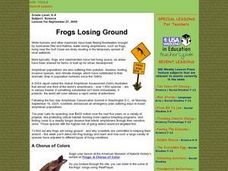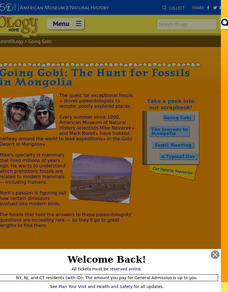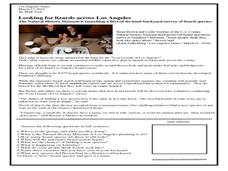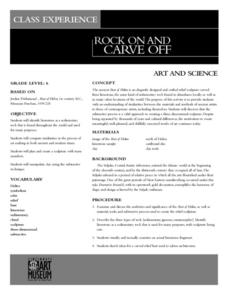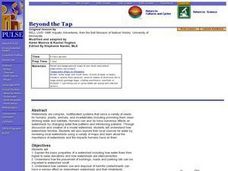National Park Service
The Young Naturalist
Beginning with a brief history of our 26th president, Theodore Roosevelt, then followed by a discussion of his interest in nature, young scientists take to the outdoors to locate and observe local plants and insects....
California Academy of Science
Poetic Reflections
Poetry is a wonderful way to explore language, express topical understanding, and incite creative thinking. After a trip to the local natural history museum (or zoo), learners write an acrostic or a cinquain poem describing one of their...
Curated OER
Teaching about the Rainforest - Classroom Ideas
Students are introduced to the tropical rainforest through different ways that catch their attention such as: Visit a local botanical garden or conservatory so that students can see the variety of tropical plants in the world. They...
Curated OER
Biomimicry, Nature: Architecture of the Future
Students explore the relationship between nature and architecture. In this cross curriculum history, culture, and architecture instructional activity, students observe and discuss structures visible in nature. Students view websites in...
Curated OER
Frogs Losing Ground
Students explore an exhibit through an interactive program on frogs. They can listen to the different sounds frogs make and the different types of frogs. They search for the types of frogs they find in their local area.
Brooklyn Children’s Museum
Rocks and Minerals in Our Lives
Young geologists discover the important role that rocks and minerals play in our everyday lives through this series of hands-on activities. Starting off with a lesson that defines the difference between plants, animals, and...
Science Friday
Fossil Detectives
What can this rock be? Pupils pretend to be paleontologists by sketching fossils and making predictions about their types. To determine whether they can identify the type of dinosaur, class members compare their observations and...
Curated OER
Inventions Change the World: The Enigma Machine
Third graders explore WWII by analyzing technological advances. In this invention lesson, 3rd graders discuss the use of the Enigma machine which decoded private German messages that communicated with U-boats. Students utilize a timeline...
Curated OER
A Fiedl Study of an Integral Species
Students compile baseline population information on a local species. They design and conduct a scientific investigation of a local species. Students interpret, analyze and communicate results based on sound scientific and mathematical...
Curated OER
Energy: Power to the People
High schoolers explore the concept of renewable energy. In this green design lesson, students research local energy issues facing their community and create policies to address the issues.
Curated OER
Mobility: A Green City, Past, Present, and Future
Students explore transportation systems through history. In this transportation lesson, students determine how modes of transportation affect quality of life and design transportation plans for cities.
Curated OER
A Sense of West Virginia
Students consider their perceptions of the world through their 5 senses while visiting the West Virginia State Museum. In this West Virginia history lesson, students discover how knowing about the past helps with their understanding of...
Curated OER
Way Down in the Deep Blue Sea
Uncover the mysterious wonders of the ocean with activities that span the subjects!
Curated OER
Hunting Invertebrate Fossils in the Classroom
Students acquire a general knowledge of fossils and paleontology, the study of evidence of life in the past and identify the major invertebrate groups (phyla) commonly found in the fossil record.
American Museum of Natural History
Going, Going...Gone?
Young environmentalists consider how scientists are attempting to save endangered species. They read about what causes extinction and steps to take to minimize the threats.
American Museum of Natural History
Saving Species
Some scientists dedicate their lives to researching and protecting endangered species. An online lesson teaches about three scientists around the world who do just that. They learn about spiders, mollusks, and reptiles from North...
American Museum of Natural History
Going Gobi: The Hunt for Fossils in Mongolia
Take a trip on a fossil hunt. Pupils read about a trip to the Gobi Desert by a group of paleontologists to find fossils. Learners view pictures taken on the trip and determine what the scientists go through in the search for answers to...
Curated OER
Looking for Lizards across Los Angeles
In this lizards worksheet, students read a 1 page passage titled Looking for Lizards across Los Angeles and then answer short answer questions about it. Students answer 10 questions.
Curated OER
Rock On And Carve Off
Sixth graders work in groups of four to create one subtractive relief bust out of clay. Team results are shared and discussed to analyze the degree of planning and skillful manipulation of materials necessary to complete a limestone bust.
Curated OER
To Tell The Truth
Students create a faux ivory napkin ring using art supplies and knowledge gained from in-class discussions and teacher supplied information in this art lesson easily adaptable to a Social Studies or Language Arts classroom.
Curated OER
The First Farmers
Students show how constant irrigation, with repeated evaporation of water that left salts in the soil, eventually ruined much farming land in southern Mesopotamia. They discuss the idea that with the development of irrigation people...
Curated OER
Why Cladistics?
Pupils explore how biological classification is intimately associated with evolution.
Curated OER
Water: H2O = Life
For this earth science worksheet, students explore and describe animals and their adaptations, including their habitats, physical characteristics, and competing organisms. They also explore and describe how others use water around the...
Curated OER
Beyond the Tap
Learners explain the basic properties of a watershed including how water flows from higher to lower elevations and how watersheds are interconnected. They comprehend how the placement of buildings, roads, and parking lots can be...


